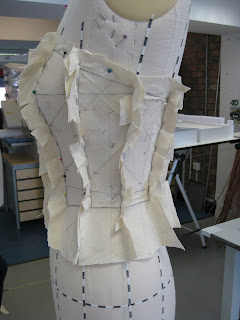I have taken on the role of principle pattern drafter and have been helping the other girls draft their corsets up- the design I'm working through at the moment is a nice little challenge for me as it is a full body corset, something that I have yet to try. This is the design I will be making.
With a rather tight schedule and having to be ultimately responsible in guiding the shapes of these corsets I decided it would be best for all if we found one corset plate that worked for all and then enlarged the pattern with the help of CAD. This got us all to a stage very quickly where we could start to adapt the patterns to the individual measurements of the girls. I don't normally work this way myself, with the exception of the green metallic cincher I made last month but it is proving to be a method that works well if you need some quick results and the shape needed is not too complicated.
This is the pattern from Jean Hunnisett's Corsets and crinolines:
With my own pattern I had to take it onto the next stage as I needed to drape on top of my flat pattern to create the body corset that will go under the crutch like a swimming costume, but must still pull in at the waist.
I started by taking the flat pattern after I had altered it and making a half up in calico and putting it on my mannequin. Luckily the measurements were not too dissimilar to my artist. I had a fiddle and re-adjusted some lines as I can identify pretty quickly if something is not working in a corset. Next I used a block for knickers as a guide for how much crutch allowances I needed and draped the rest straight onto the mannequin. I could see the results were working really well. From the draping to the final pattern all I did was true up the seams and tweak the shape a little.
After this I cut in drill, transferred my markings in chalk (I used red which was very messy and rubbed off in areas on the white drill, I wont be doing that again!)
Next- and this is my *cheat* for keeping the wrinkles down, especially with satin; I backed the drill to double sided fusible glue, the type that comes on paper and it has a honeycomb shape that melts into one fabric and then you iron to the other fabric, sandwiching them together. Followed by the satin itself. Here it is waiting to be tacked and sewn together.
The next update will be along shortly as it is already half constructed at my machine as I type. I will be leaving a side seam open as it will have a strong zip inserted to enable the dancer to remove it during performance. But so far I'm quite happy with the relative ease of making it into a full body, it's something that I thought would be far more complicated but this has given me the confidence to go straight into some more challenging shapes on my next sample. I found the combination of part flat draft and part draping to be really liberating and is a technique I have no doubt I will be returning to. Of course I wont really know if it is a success until the fitting, and it is a slight worry we have gone straight into top fabric as there was just no time for a fitting, which is why I have cut the gusset and then left the possibility for enlargement of up to four inches front and back to get the fit right. Fingers crossed then.











































